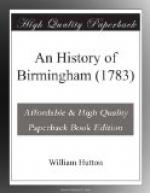[Footnote 7: He measured about six feet five inches, but was singularly short in the lower parts: his step was not larger than a child’s of ten years old. His carriage, by its extraordinary height, looked at a distance like a moving steeple; he sat as high in a common chair, as a man of the middle-size stands: he was as immoderately heavy as he was tall, and as remarkable for good-nature as either. As a man, he shone by his bulk; as a magistrate, in a dull but honest light—his decisions were intended to be just. He seemingly dozed as he walked; but if his own eyes were half shut, those of every other person were open to see him.]
It lies in a pleasant situation, upon a descent, so that the trench in one part is dry, and in another three or four yards deep in water.
A place of such desolation, one would think, was a place of silence—just the reverse. When I saw it, Feb. 23, 1783, the trees were tall, the winds high, and the roar tremendous.
Exclusive of Ulverley and Hogg’s-moat, there are many old foundations in Solihull, once the residence of gentry now extinct; as Solihull-hall, the Moat-house, and Kynton, the property of the Botolers; Bury-hall, that of the Warings; who both came over with William: Henwood, belonging to the Hugfords; Hillfield-hall, the ancient seat of the Greswolds, as Malvern was their modern.
YARDLEY.
At Yardley church, four miles east of Birmingham, is The Moat, now a pasture; the trench still retains its water, as a remembrance of its former use.
This was anciently the property of the Allestrees, lords of Witton; but about thirty years ago, the building and the family expired together.
KENT’S-MOAT.
One mile farther east is Kent’s-moat, in which no noise is heard but the singing of birds, as if for joy that their enemy is fled, and they have regained their former habitation.
This is situate on an eminence, like that of Park-hall, is capacious, has but one trench, supplied by its own springs; and, like that, as complete as earth and water can make it.
This was part of Coleshill, and vested in the crown before the conquest, but soon after granted with that to Clinton, who gave it with a daughter to Verdon; and he, with another, to Anselm de Scheldon, who kept it till the reign of Edward the Third: it afterwards passed through several families, till the reign of Henry the Seventh, when it came into that of De Gray, Earl of Kent, whence the name; though, perhaps, the works were erected by Scheldon.
It is now, with Coleshill, the property of Lord Digby; but the building has been so long gone, that tradition herself has lost it.
SHELDON.
One mile east is Sheldon-hall, which anciently bore the name of East-hall, in contradistinction from Kent’s-moat, which was West-hall. This, in 1379, was the property of Sir Hugh le Despenser, afterwards of the family of Devereux, ancestor of the present Viscount Hereford, who resided here till about 1710. In 1751, it was purchased by John Taylor, Esq; and is now possessed by his tenant.




